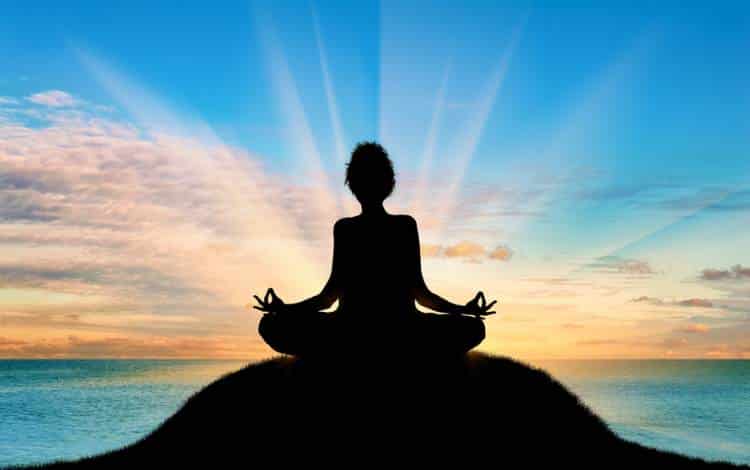
Raja Yoga, often referred to as the “royal path” of yoga, is a profound and ancient form of yoga that focuses on the mind and its control.
Unlike some other forms of yoga which emphasize physical postures or breath control, Raja Yoga prioritizes the mental and spiritual aspects, aiming to achieve a state of pure consciousness or enlightenment.
This short guide explores the essence of Raja Yoga, its historical roots, and practical steps for incorporating its practices into your life.
What Is Raja Yoga?
Browse our online courses on meditation, positive thinking, overcoming procrastination, and freedom from distractions.
Raja Yoga is one of the six orthodox schools of Hindu philosophical traditions. Patanjali, often regarded as the father of yoga, compiled these sutras around the 2nd century BCE. They provide a systematic approach to achieving the spiritual state of ‘Samadhi,’ or union with the divine.
The term “Raja” means king or royal, signifying that this path is considered the highest and most direct path to self-realization and enlightenment. It is designed to harness the mental faculties through disciplined meditation, leading to mastery over the mind and, ultimately, the realization of one’s true nature.
Who Taught Raja Yoga?
The foundational text of Raja Yoga is the Yoga Sutras, attributed to Patanjali. This ancient sage is somewhat shrouded in mystery, with little definitive information about his life.
However, his works have profoundly influenced not just Raja Yoga but all forms of yoga, delineating a philosophical framework and methodical path to spiritual emancipation.
Throughout history, numerous yogis and spiritual leaders have taught and expanded on the principles of Raja Yoga. In modern times, Swami Vivekananda was one of the main advocates for bringing the teachings of Raja Yoga to a global audience.
In the late 19th century, he introduced the concepts of Raja Yoga to the West through his lectures and books, elucidating its psychological and meditative aspects. His book, “Raja Yoga,” provides insights into Patanjali’s sutras along with a practical guide to meditation and spirituality.
The Eight Limbs of Raja Yoga
Raja Yoga is structured around Patanjali’s eight limbs, which serve as steps on the path to spiritual growth:
1. Yama (Moral Restraints): These are ethical considerations that a practitioner should observe toward others, including nonviolence, truthfulness, nonstealing, celibacy, and noncovetousness.
2. Niyama (Observances): These self-disciplines relate to the individual’s internal world and include purity, contentment, self-discipline, self-study, and surrender to a higher power.
3. Asana (Posture): While commonly associated with physical yoga poses, in Raja Yoga, asana refers primarily to the seated position used for meditation, emphasizing stability and comfort to facilitate prolonged meditation.
4. Pranayama (Breath Control): This involves techniques designed to control the life force (prana) through regulated breathing. It serves to prepare the mind for meditation by fostering a deeper connection between the body, mind, and spirit.
5. Pratyahara (Withdrawal of the Senses): This step involves drawing the senses away from external objects to reduce distractions during meditation, helping the practitioner to inwardly focus.
6. Dharana (Concentration): Dharana involves focusing the mind on a single object, thought, or mantra, which helps to stabilize the mind and deepen concentration.
7. Dhyana (Meditation): This uninterrupted flow of concentration evolves into meditation. Dhyana is more profound than dharana as the meditator becomes increasingly absorbed in the meditation object.
8. Samadhi (Superconscious State): The ultimate goal, Samadhi, is a state of bliss and peace achieved through deep meditation, where the individual’s consciousness surpasses the mind and ego, leading to a realization of the true Self.
You might like reading quotes about concentration.
How to Practice Raja Yoga
Practicing Raja Yoga involves dedication to all eight limbs, integrating ethical practices, bodily discipline, breath control, and meditation. Here is a simplified way to start practicing Raja Yoga:
1. Start with Ethics and Self-discipline: Begin by incorporating the Yamas and Niyamas (moral restraints and observances) into your daily life. Reflect on how you can practice non-violence, truthfulness, and purity each day.
2. Establish a Steady Meditation Posture: Learn a comfortable seated posture that allows you to sit erect without discomfort for prolonged periods. This could be the lotus position or simply sitting on a chair with feet flat on the ground.
3. Explore Breath Control: Integrate basic pranayama practices such as alternate nostril breathing (Nadi Shodhana) to calm the mind and prepare it for meditation.
4. Practice Withdrawal of the Senses: Begin by minimizing distractions during meditation, by meditating in a quiet place, and using techniques such as focusing on the breath to draw attention inward.
5. Concentration and Meditation: Start with short periods of concentration on a chosen object or mantra. Gradually increase the time spent in meditation, allowing the practice of Dharana (concentration of the mind) to evolve naturally into Dhyana (concentration of the mind).
6. Seek Guidance: Guidance from a knowledgeable teacher can be invaluable, especially in the early stages, in navigating the subtleties of meditation and the spiritual path.
7. Be Patient and Persistent: The benefits of Raja Yoga unfold over time with regular and sustained practice. Patience and persistence are key in deepening your practice and advancing on this spiritual journey.
The Power of Raja Yoga
Raja Yoga offers a structured and profound approach to achieving inner peace and enlightenment. However, it requires discipline, inner strength, and focus to practice.
This is a short guide about Raja Yoga, but a good start. If you wish to learn more about this topic, you can read the Book “Raja Yoga” by Patanjali.
There are also websites about Raja Yoga, which you can explore.
Learn About Our Online Meditation Course
Various meditation techniques for finding inner peace, expanding consciousness, and awakening.
By following its systematic path and integrating its principles into everyday life, practitioners can attain a deep sense of serenity and self-awareness, ultimately leading to spiritual liberation.
Whether you are a seasoned yogi or a curious beginner, Raja Yoga can offer a transformative experience. It will guide you to a deeper understanding of your mind and its infinite possibilities.
Image source – DepositPhotos
Browse our online courses on meditation, positive thinking, overcoming procrastination, motivation, and freedom from distractions.


